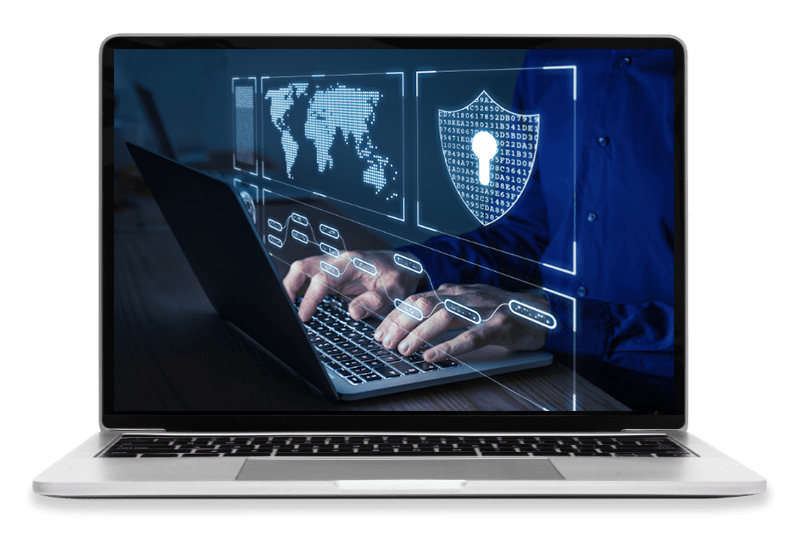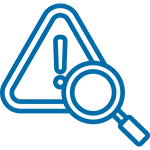Transform your cyber risk assessments by implementing the ideal risk management framework
Learn about the core components of a risk management framework and the benefits of implementing such a framework for cyber risk assessments.
Transform your cyber risk assessments by implementing the ideal risk management framework
Learn about the core components of a risk management framework and the benefits of implementing such a framework for cyber risk assessments.
What’s a risk management framework and what does it consist of?

We live in an age where cybersecurity is a top priority for most organisations across industries, as the frequency, severity, and sophistication of cyberattacks keep ramping up every day.
Last year alone saw 76,000 cyber crimes committed, with a report being filed every seven minutes. This makes conducting a cyber risk assessment a vital requirement that should not be overlooked.
But, for a cyber risk assessment to be effective, organisations must implement a robust and comprehensive risk management framework.
What’s a risk management framework and what does it consist of?

A risk management framework provides organisations with the guidelines to ensure that their risk management processes are aligned with the leading international security risk standards such as ISO 31000:2018.
It usually consists of four main components:
Context establishment
This involves identifying the factors that influence an organisation’s risk profile such as policies, standards, regulations, stakeholders, resources, capabilities and processes, and defining the scope, objectives, criteria and assumptions of cyber risk assessments, ensuring that all SRM professionals have a clear understanding of their risk landscape.
Risk identification
Once the context of the risk assessment has been established, organisations can start identifying the sources of security incidents and the impact these incidents can have on the organisation’s operations and assets such as financial, reputational, and operational losses. The most common source of cyber risks are human errors and technical failures.
Risk analysis
Risk analysis involves estimating the probability of security incidents occurring and the impacts these incidents can have on an organisation’s assets and objectives through either a qualitative or quantitative analytical approach. This could be done by leveraging risk matrices, bow tie assessments, and other similar risk assessment tools.
Risk evaluation
This final component involves comparing the results of qualitative and quantitative risk analysis with the predefined risk criteria and thresholds—which defines an organisation’s risk appetite, tolerance, and limits—to decide on the priority of each potential risk vector and then allocate resources accordingly to mitigate/minimise cybersecurity risks.
What are the benefits of implementing a risk management framework?
Helps take a more holistic approach to risk management
Risk assessments are not a one-and-done task, as they need to be repeated and updated frequently to gauge the effectiveness of risk controls against evolving cyber risks and risk management frameworks to provide a foundation for continuous monitoring.
Improves resource allocation
While it’s important to focus on all cyber risks to ensure the integrity of organisational assets and information, not all risks require the same level of attention. Having a proper framework will enable the efficient allocation of resources.
Provides a basis for developing treatment options
Cyber risk assessments when aligned with a comprehensive risk management framework provide adequate and actionable information that can be leveraged to formulate effective risk treatment options such as avoidance, mitigation, transferal, or acceptance.
Some of the industries we serve
Government
Identify, monitor, and manage systemic risks associated with policy implementation, public safety, and national security with a scalable and configurable risk assessment solution.
Critical infrastructure
Obtain insights to identify and mitigate potential threats to critical infrastructure like energy, transportation, and communication systems through professional risk assessments.
Mining
Ensure safe, secure, and efficient operations and overcome common mining challenges like equipment failure and environmental hazards via a professional risk assessment solution.
Defence
Obtain a comprehensive view of potential threats to national and regional security and implement effective risk management strategies with military-grade risk assessment solutions.
Healthcare
Ensuring the safety of patients, staff, and other stakeholders while managing risks associated with medical procedures and data privacy through a configurable risk assessment solution.
Finance
Identify, monitor, and manage critical risks like market volatility and data breaches with a risk assessment solution to protect stakeholder assets and ensure regulatory compliance.
Consultancy
Help your clients make informed decisions about risk management by leveraging insights from a professional risk assessment solution that helps identify, address, and monitor risks.
Cybersecurity
Protect your digital assets with our advanced cybersecurity risk assessment solutions. Stay ahead of evolving threats and fortify your defences with comprehensive risk assessments.
Education
Identify and mitigate compliance, finance, operational, and reputational risks in processes such as student selection and regulatory adherence with professional risk assessments.
Adopt international standards-aligned risk management framework with SECTARA

We built SECTARA to provide SRM professionals the tools they need to conduct risk assessments that are aligned with all major national and international security risk management standards including SRMBoK, ISO 31000, ISO 27000, Standards Australia’s Handbook 167 and more.
SECTARA’s robust features are designed to make cyber security risk assessment a breeze for SRM professionals.
Adopt international standards-aligned risk management framework with SECTARA

We built SECTARA to provide SRM professionals the tools they need to conduct risk assessments that are aligned with all major national and international security risk management standards including SRMBoK, ISO 31000, ISO 27000, Standards Australia’s Handbook 167 and more.
SECTARA’s robust features are designed to make cyber security risk assessment a breeze for SRM professionals.
Want to experience how SECTARATM works first-hand?
Sign up for our 14-day free trial today
Start your 14-day free trial
What you get with our free trial
2 users (Account Admin, Org & BU Admin, Assessor, Viewer)
2 concurrent assessments
2 organisations & business units
In product training
The ability to export assessments to MS Word
MS Excel treatment plans
White label SECTARATM platform
White-label exported documents
Audit records
Want to experience how SECTARATM works first-hand?
Sign up for our 14-day free trial today
What you get with our free trial
2 users (Account Admin, Org & BU Admin, Assessor, Viewer)
2 concurrent assessments
2 organisations & business units
In product training
The ability to export assessments to MS Word
MS Excel treatment plans
White label SECTARATM platform
White-label exported documents
Audit records
Start your 14-day free trial





